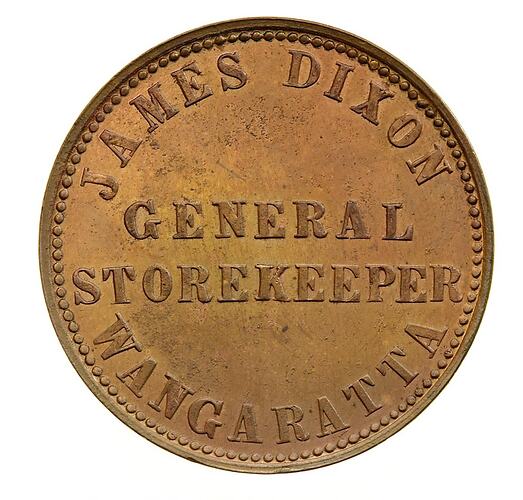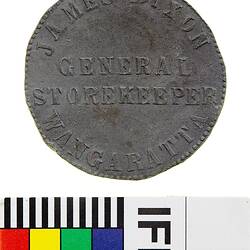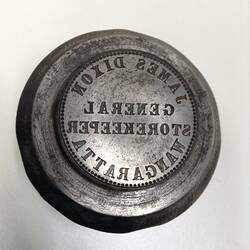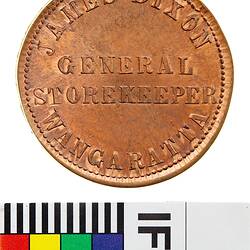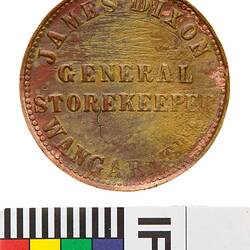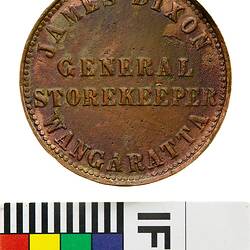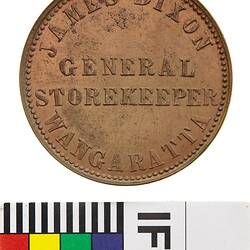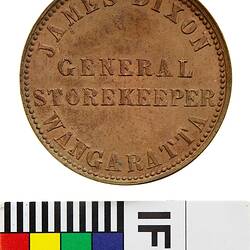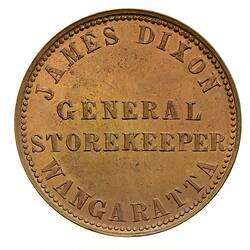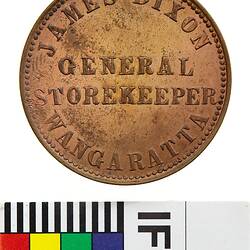Six varieties of tokens issued by James Dixon are known to exist, but none of them are believed to have been issued into circulation. The dies from which the tokens were made were dated 1862.
Dixon came from Harvey, New Brunswick in Canada and is said to have arrived in Melbourne in 1851. He began a cartage business, moving goods between Sandridge (Port Melbourne) and the city, and after gold was found, between the city and the goldfields.He was said to have been a forester in Canada, 'a very powerful man, standing over six feet in height, and weighed about eighteen stone, and was recognised as the strongest man on the road'. Gardner tells a story about Dixon getting bogged at Black Forest en route to the gold fields, along with a number of other carriers. He is said to have unloaded his bogged dray and got it free, 'arriving at the goldfield when flour was at famine prices,' and making big profit as a result. (Gardner)
When he decided to settle down, Dixon opened a general store at Wangaratta, in about 1860. Andrews believes that he may have suffered a business crisis around 1862, for although Thomas Stokes made an obverse die for him (now in the MV collection), the tokens are not known to have circulated, and may never have even been struck at this time. Regardless of any problems he may have had in the early 1860s, in 1866 Dixon was listed as the proprietor of a General Store in Ryley street, Wangaratta, in Butler & Brookes' Victorian Directory for 1866-1867. Gardner does not mention any serious reverse of Dixon's business during the 1860s, instead relating that he purchased a flour mill in 1867. The mill, unfortunately, was not a steady business: 'He was very successful for some time during the good seasons; but at the end of the fifth year the season was a bad one, and he became involved through over speculation in wheat, with disastrous results'.
Following the collapse of his milling business, Dixon returned to Melbourne in 1892, and went to Western Australia before retiring to Sydney. He died on 2 September 1910. He and his wife had 10 children, of whom four were still living in 1913. (Gardner, p.10)
Note: James Dixon is not listed as a flourmiller at Wangaratta in Lewis & Peggy Jones' authorative work on Victorian Flour Mills, suggesting that he perhaps did not own his flourmill outright. It is possible that he leased Burrows & Tomlins' North Wangaratta Flour Mills between 1866 and 1872 (Jones, p.315).
References:
Gardner, F. (1913). 'Trade tokens and the firms who issued them', The Australian Storekeepers and Traders Journal, 30 April, p.10.
Sharples, J. (1993). 'Catalogue of Victorian Trade Tokens' in Journal of the Numismatic Association of Australia, Vol. 7, December, p.76.
Andrews, A. (1921). Australasian Tokens and Coins, 1921, p.41.
Butler & Brookes Victorian Directory for 1866-1867.
Jones, Lewis & Peggy, The Flour Mills of Victoria 1840-1990 - An Historical Record, The Flourmillers' Council of Victoria, 1990.
More Information
-
Keywords
-
Localities
-
Authors
-
Article types
